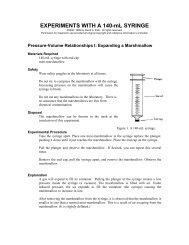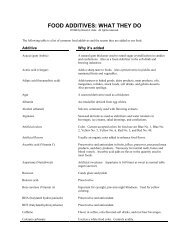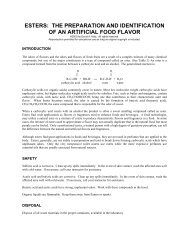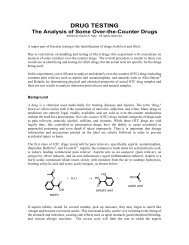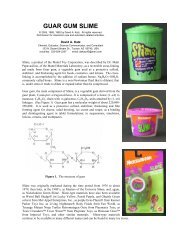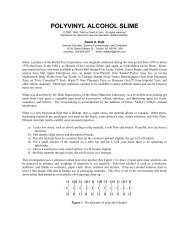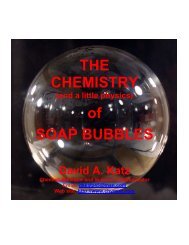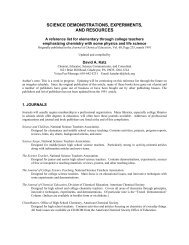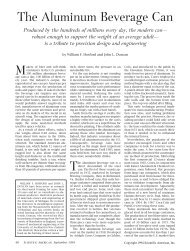WRITING CHEMICAL EQUATIONS - chymist.com
WRITING CHEMICAL EQUATIONS - chymist.com
WRITING CHEMICAL EQUATIONS - chymist.com
You also want an ePaper? Increase the reach of your titles
YUMPU automatically turns print PDFs into web optimized ePapers that Google loves.
<strong>WRITING</strong> <strong>CHEMICAL</strong> <strong>EQUATIONS</strong><br />
©2004, 2002, 1989 by David A. Katz. All rights reserved.<br />
Permission for classroom used provided original copyright is included.<br />
David A. Katz<br />
Chemist, Educator, Science Communicator, and Consultant<br />
Department of Chemistry, Pima Community College<br />
I. THE MEANING OF A <strong>CHEMICAL</strong> EQUATION<br />
A chemical equation is a chemist’s shorthand expression for describing a chemical change. As an example, -<br />
consider what takes place when iron rusts. The equation for this change is:<br />
Fe + O 2 → Fe 2O 3<br />
In this expression, the symbols and formulas of the reacting substances, called the reactants, are written on the left<br />
side of the arrow and the products of the reaction are written on the right side. The arrow is read as “gives”,<br />
“yields”, or “forms” and the plus (+) sign is read as “and”. When the plus (+) sign appears between the formulas for<br />
two reactants, it can be read as “reacts with”. (The + sign does not imply mathematical addition.)<br />
The equation, above, can be read as iron reacts with oxygen to yield (or form) iron(III) oxide.<br />
II. BALANCING A <strong>CHEMICAL</strong> EQUATION<br />
As it is written, the equation indicates in a qualitative way what substances are consumed in the reaction and what<br />
new substances are formed. In order to have quantitative information about the reaction, the equation must be<br />
balanced so that it conforms to the Law of Conservation of Matter. That is, there must be the same number of atoms<br />
of each element on the right hand side of the equation as there are on the left hand side.<br />
If the number of atoms of each element in the equation above are counted, it is observed that there are 1 atom of Fe<br />
and 2 atoms of O on the left side and 2 atoms Fe and 3 atoms of O on the right.<br />
Fe + O 2 → Fe 2O 3<br />
Left side: Right side:<br />
1 atom Fe 2 atoms Fe<br />
2 atoms O 3 atoms O<br />
The balancing of the equation is ac<strong>com</strong>plished by introducing the proper number or coefficient before each formula.<br />
To balance the number of O atoms, write a 3 in from of the O 2 and a 2 in front of the Fe 2O 3:<br />
Fe + 3 O 2 → 2 Fe 2O 3<br />
The equation, above, now has 6 atoms of O on each side, but the Fe atoms are not balanced. Since there is 1 atom<br />
of Fe on the left and 4 atoms of Fe on the right, the Fe atoms can be balanced by writing a 4 in front of the Fe:<br />
4 Fe + 3 O 2 → 2 Fe 2O 3<br />
This equation is now balanced. It contains 4 atoms of Fe and 6 atoms of O on each side of the equation. The<br />
equation is interpreted to mean that 4 atoms of Fe will reaction with 3 molecules of O 2 to form 2 molecules of<br />
Fe 2O 3.
It is important to note that the balancing of an equation is ac<strong>com</strong>plished by placing numbers in front of the proper<br />
atoms or molecules and not as subscripts. In an equation, all chemical species appear as correct formula units. The<br />
addition (or change) of a subscript changes the meaning of the formula unit and of the equation. Coefficients in<br />
front of a formula unit multiply that entire formula unit.<br />
Another example of balancing an equation is:<br />
Al(OH) 3 + H 2SO 4 → Al 2(SO 4) 3 + H 2O<br />
Counting the atoms of each element in the equation it is found that there are 1 atom Al, 7 atoms O, 5 atoms H, and 1<br />
atom S on the left side and 2 atoms Al, 13 atoms O, 2 atoms H, and 3 atoms S on the right side.<br />
Al(OH) 3 + H 2SO 4 → Al 2(SO 4) 3 + H 2O<br />
Left side: Right side:<br />
1 atom Al 2 atoms Al<br />
7 atoms O 13 atoms O<br />
5 atoms H 2 atoms H<br />
1 atom S 3 atoms S<br />
The counting, however, can be simplified by observing that the S and O in the SO 4 polyatomic ion acts as a single<br />
unbreakable unit in this equation. Recounting, using the SO 4 as a single unit, it is found that there are 1 atom Al, 3<br />
atoms O, 5 atoms H, and 1 SO 4 polyatomic ion on the left side and 2 atoms Al, 1 O atom, 2 H atoms, and 3 SO 4<br />
polyatomic ions on the right side.<br />
Al(OH) 3 + H 2SO 4 → Al 2(SO 4) 3 + H 2O<br />
Left side: Right side:<br />
1 atom Al 2 atoms Al<br />
3 atoms O 1 atoms O<br />
5 atoms H 2 atoms H<br />
1 SO 4 group 3 SO 4 groups<br />
Starting with Al, the atoms of Al can be balanced by writing a 2 in front of the Al(OH) 3:<br />
2 Al(OH) 3 + H 2SO 4 → Al 2(SO 4) 3 + H 2O<br />
Looking at the SO 4 ions, these are balanced by writing a 3 in front of the H 2SO 4:<br />
2 Al(OH) 3 + 3 H 2SO 4 → Al 2(SO 4) 3 + H 2O<br />
Now, only the O atoms and H atoms remain unbalanced. There are 6 atoms of O and 12 atoms of H on the left hand<br />
side of the equation and only 1 atom O and 2 atoms H on the right side. These can be balanced by writing a 6 in<br />
front of the H 2O:<br />
2 Al(OH) 3 + 3 H 2SO 4 → Al 2(SO 4) 3 + 6 H 2O<br />
The equation is now balanced and it is interpreted to mean that 2 molecules of Al(OH) 2 react with 3 molecules of<br />
H 2SO 4 to form 1 molecule of Al 2(SO 4) 3 and 6 molecules H 2O.<br />
2
Problems: Balancing chemical equations<br />
Balance each of the following equations:<br />
1. H 2 + Br 2 → HBr<br />
2. N 2 + H 2 → NH 3<br />
3. Sb + O 2 → Sb 4O 6<br />
4. Cu(NO 3) 2 → CuO + NO 2 + O 2<br />
5. (NH 4) 2Cr 2O 7 → Cr 2O 3 + N 2 + H 2O<br />
6. C 2H 6 + O 2 → CO 2 + H 2O<br />
7. Al + HgCl 2 → AlCl 3 + Hg<br />
8. FeS + O 2 → Fe 2O 3 + SO 2<br />
9. KOH + Cl 2 → KCl + KClO + H 2O<br />
10. Ca(OH) 2 + H 3PO 4 → Ca 3(PO 4) 2 + H 2O<br />
11. BaCl 2 + Na 2SO 4 → BaSO 4 + NaCl<br />
12. CrBr 3 + Na 2SiO 3 → Cr 2(SiO 3) 3 + NaBr<br />
Not all equations can be easily balanced by the method used here. In some equations the oxidation numbers of<br />
some atoms change during the reaction. Such equations are known as oxidation-reduction equations and many of<br />
these require special methods to balance them. Although the balancing of oxidation-reduction equations will not be<br />
covered in this tutorial, the following oxidation reduction equation is provided as an exercise:<br />
Balance the following equation:<br />
Cu + HNO 3 → Cu(NO 3) 2 + NO + H 2O<br />
3
III. TYPES OF <strong>CHEMICAL</strong> REACTIONS<br />
Most inorganic reactions can be classified into one of five general categories: direct union or <strong>com</strong>bination,<br />
de<strong>com</strong>position, displacement, metathesis or double displacement, and <strong>com</strong>bustion reactions. Each of these will be<br />
discussed in more detail in the following sections.<br />
1. Direct Union or Combination Reactions<br />
Any reaction in which two or more substances <strong>com</strong>bine to form a single product is a direct union or<br />
<strong>com</strong>bination reaction. The general form of a direct union reaction is<br />
A + B → AB<br />
This type of reaction generally takes place between the following types of <strong>com</strong>pounds:<br />
a. A metal + non-metal<br />
b. Metal oxide + non-metal oxide<br />
c. Non-metal + non-metal<br />
2. De<strong>com</strong>position Reactions<br />
2 Na + Cl 2 → 2 NaCl<br />
sodium chloride<br />
Fe + S → FeS<br />
iron(II) sulfide<br />
K 2O + SO 3 → K 2SO 4<br />
potassium sulfur potassium<br />
oxide trioxide sulfate<br />
CaO + CO 2 → CaCO 3<br />
calcium carbon calcium<br />
oxide dioxide carbonate<br />
C + O 2 → CO 2<br />
carbon<br />
dioxide<br />
N 2 + 3 Cl 2 → 2 NCl 3<br />
nitrogen<br />
trichloride<br />
De<strong>com</strong>position is the reverse of <strong>com</strong>bination. That is, a single reactant is broken down into two or more<br />
products either elements or <strong>com</strong>pounds. A de<strong>com</strong>position reaction will take place because the <strong>com</strong>pound<br />
is unstable or as a result of heating or electrical de<strong>com</strong>position (electrolysis). The general form for a<br />
de<strong>com</strong>position reaction is:<br />
AB → A + B<br />
Some examples of de<strong>com</strong>position reactions are:<br />
4
2 HgO → 2 Hg + O 2<br />
mercury(II)<br />
oxide<br />
2 KClO 3 → 2 KCl + 3 O 2<br />
potassium potassium<br />
chlorate chloride<br />
CaCO 3 → CaO + CO 2<br />
calcium calcium carbon<br />
carbonate oxide dioxide<br />
To understand how to predict products of de<strong>com</strong>position reactions, see Section V. The Effect of Heat on<br />
Metallic Compounds, page 11.<br />
3. Displacement Reactions (Sometimes called oxidation-reduction equations)<br />
A displacement reaction involves an element reacting with a <strong>com</strong>pound whereby the element displaces a<br />
second element from the <strong>com</strong>pound. The general form of this type reaction is:<br />
A + BC → AC + B<br />
Displacement reactions usually occur between the following <strong>com</strong>binations:<br />
a. An active metal + an acid<br />
When a metal which is above hydrogen in the activity series is reacted with an acid, hydrogen is<br />
liberated and a salt is formed. (Refer to Section IV, The Electromotive Series, page 9)<br />
b. A metal + a salt<br />
Zn + 2 HCl → ZnCl 2 + H 2<br />
hydrochloric zinc<br />
acid chloride<br />
Mg + H 2SO 4 → MgSO 4 + H 2<br />
sulfuric magnesium<br />
acid sulfate<br />
Each metal in the activity series displaces any metals below it to form a salt in solution. (Refer to<br />
Section IV, The Electromotive Series, page 9)<br />
Cu + 2 AgNO 3 → Cu(NO 3) 2 + 2 Ag<br />
silver copper(II)<br />
nitrate nitrate<br />
Fe + CuSO 4 → FeSO 4 + Cu<br />
copper(II) iron(II)<br />
sulfate sulfate<br />
5
c. A Halogen + halide salt<br />
A halogen (F, Cl, Br, I, At) will displace any less active halogen from a halide salt. The order of<br />
activity decreases going from top to bottom down the halogen family in the periodic table.<br />
Cl 2 + 2 NaI → 2 NaCl + I 2<br />
sodium sodium<br />
iodide chloride<br />
4. Metathesis or Double Displacement Reactions<br />
A metathesis is a double displacement reaction that usually occurs in water solution. The general form of<br />
a metathesis reaction is:<br />
AB + CD → AD + CB<br />
In order to have any appreciable degree of <strong>com</strong>pletion of metathesis reactions, one or both of the<br />
products must be<strong>com</strong>e unavailable for the reverse reaction. the principal conditions that favor the<br />
<strong>com</strong>pletion of these reactions are:<br />
(1) Formation of an insoluble <strong>com</strong>pound - a precipitate<br />
(2) Formation of a gas<br />
(3) Formation of water<br />
Metathesis reactions are generally classified as precipitation reactions or as neutralization reactions.<br />
a. Precipitation Reactions<br />
In this type of reaction, two <strong>com</strong>pounds which are water soluble react to form two new <strong>com</strong>pounds,<br />
one of which is a precipitate (i.e. insoluble in water). The precipitate is often indicated by an arrow<br />
pointing downward, ↓, written next to its formula.<br />
AgNO 3 + NaCl → AgCl ↓ + NaNO 3<br />
silver sodium silver sodium<br />
nitrate chloride chloride nitrate<br />
BaCl 2 + K 2SO 4 → BaSO 4 ↓ + 2 KCl<br />
barium potassium barium potassium<br />
chloride sulfate sulfate chloride<br />
In order to determine which one of the products will be the precipitate requires a knowledge of the<br />
solubilities of salts in water. The rules governing the solubility of <strong>com</strong>mon salts are given below:<br />
THE SOLUBILITY RULES<br />
1. All sodium, potassium, and ammonium salts are soluble in water.<br />
2. The nitrates, chlorates, and acetates of all metals are soluble in water. Silver acetate is sparingly<br />
soluble.<br />
3. The chlorides, bromides, and iodides of all metals except lead, silver, and mercury(I) are soluble in<br />
water. PbCl 2, PbBr 2, and PbI 2 are soluble in hot water.<br />
6
4. The sulfates of all metals except lead, mercury(I), barium, and calcium are soluble in water.<br />
Ag 2SO 4 is slightly soluble.<br />
5. The carbonates, phosphates, borates, sulfites, chromates, and arsenates of all metal except sodium,<br />
potassium, and ammonium are insoluble in water.<br />
6. The sulfides of all metals except barium, calcium, magnesium, sodium, potassium, and ammonium<br />
are insoluble in water.<br />
7. The hydroxides of sodium, potassium, and ammonium are very soluble in water. The hydroxides<br />
of calcium and barium are moderately soluble. The oxides and hydroxides of all other metals are<br />
insoluble.<br />
b. Neutralization Reactions (sometimes called acid-base reactions)<br />
A neutralization reaction occurs between an acidic <strong>com</strong>pound and a basic <strong>com</strong>pound to form a<br />
chemical salt and water.<br />
1. Reaction between an acid and a base<br />
HCl + NaOH → NaCl + H 2O<br />
hydrochloric sodium sodium water<br />
acid hydroxide chloride<br />
H 2SO 4 + Mg(OH) 2 → MgSO 4 + H 2O<br />
sulfuric magnesium magnesium water<br />
acid hydroxide sulfate<br />
2. Reaction between a metal oxide and an acid.<br />
When oxides of many metals are added to water, bases are formed.<br />
CaO + H 2O → Ca(OH) 2<br />
calcium calcium<br />
oxide hydroxide<br />
(a metal oxide) (a base)<br />
Generally, these metal oxides are called basic anhydrides and they act like bases when mixed with<br />
acids.<br />
CaO + 2 HCl → CaCl 2 + H 2O<br />
calcium hydrochloric calcium<br />
oxide acid chloride<br />
Na 2O + 2 HNO 3 → 2 NaNO 3 + H 2O<br />
sodium nitric sodium<br />
oxide acid nitrate<br />
3. Reaction between a non-metal oxide and a base.<br />
Many non-metal oxides are classified as acid anhydrides.<br />
These form acids when mixed with water.<br />
7
SO 2 + H 2O → H 2SO 3<br />
sulfur sulfurous<br />
dioxide acid<br />
(a non-metal<br />
oxide)<br />
Non-metal oxides act as acids when mixed with a base.<br />
5. Combustion Reactions<br />
SO 2 + 2 NaOH → Na 2SO 3 + H 2O<br />
sulfur sodium sodium<br />
dioxide hydroxide sulfite<br />
CO 2 + Ca(OH) 2 → CaCO 3 + H 2O<br />
carbon calcium calcium<br />
dioxide hydroxide carbonate<br />
Combustion reactions generally apply to organic <strong>com</strong>pounds, such as hydrocarbons, which are used as<br />
fuels. In these cases, the <strong>com</strong>pound is being burned in air (or oxygen) and producing carbon dioxide and<br />
water as products. A general form for a <strong>com</strong>bustion reaction is:<br />
CnH2n+2 + ( 3n + 1)<br />
O2 → n CO2 + (n+1) H2O<br />
2<br />
Note: The actual coefficients will vary based on the <strong>com</strong>position of the starting <strong>com</strong>pound.<br />
Some examples of <strong>com</strong>bustion reactions are:<br />
C3H8 + 5 O2 → 3 CO2 + 4 H2O<br />
propane<br />
2 C4H10 + 9 O2 → 8 CO2 + 10 H2O<br />
butane<br />
C2H5OH + 3 O2 → 2 CO2 + 3 H2O<br />
ethanol<br />
8
IV. THE ELECTROMOTIVE (ACTIVITY) SERIES OF METALS<br />
The Activity Series of Metals<br />
1. Li - Lithium<br />
2. K - Potassium<br />
3. Ba - Barium<br />
4. Sr - Strontium<br />
5. Ca - Calcium<br />
6. Na - Sodium<br />
7. Mg - Magnesium<br />
8. Al - Aluminum<br />
9. Mn - Manganese<br />
10. Zn - Zinc<br />
11. Cr - Chromium<br />
12. Fe - Iron<br />
13. Cd - Cadmium<br />
14. Co - Cobalt<br />
15. Ni - Nickel<br />
16. Sn - Tin<br />
17. Pb - Lead<br />
18. H - HYDROGEN<br />
19. Sb - Antimony<br />
20. As - Arsenic<br />
21. Bi - Bismuth<br />
22. Cu - Copper<br />
23. Hg - Mercury(I)<br />
24. Ag - Silver<br />
25. Pd - Palladium<br />
26. Hg - Mercury(II)<br />
27. Pt - Platinum<br />
28. Au - Gold<br />
d. Metals 1-13 react with steam to liberate hydrogen<br />
Example:<br />
Facts About the Activity Series<br />
a. The metals are arranged in the order of decreasing<br />
activity (i.e. their ability to pass into ionic form by losing<br />
electrons).<br />
Example:<br />
Lithium is more active than potassium, while<br />
potassium is more active than barium, etc...<br />
b. Each metal displaces any metal below it from dilute<br />
water solutions.<br />
Example:<br />
9<br />
Fe + CuSO 4 → FeSO 4 + Cu<br />
(Fe is above Cu in the activity series.)<br />
Fe + AlCl 3 → No Reaction<br />
(Fe is below Al in the activity series.)<br />
c. Metals 1 - 6 react with cold water to liberate hydrogen,<br />
forming metal hydroxides. Metal 7 (Mg) displaces<br />
hydrogen from hot water.<br />
Example:<br />
2 Al + 3 H 2O → Al 2O 3 + 3 H 2<br />
steam<br />
Ni + H 2O → No Reaction<br />
steam<br />
e. Metals 1-17 react with acids to liberate hydrogen<br />
Example:<br />
Sn + 2 HCl → SnCl 2 + H 2<br />
Hg + H 2SO 4 → No Reaction<br />
Sr + 2 H 2O → Sr(OH) 2 + H 2<br />
cold<br />
Co + H 2O → No Reaction<br />
cold
Reaction of metals with nitric acid results in a de<strong>com</strong>position of the nitric acid along with a displacement<br />
reaction. With active metals such as iron and zinc, the reaction with concentrated nitric acid is:<br />
4 Zn + 10 HNO 3 → 4 Zn(NO 3) 2 + N 2O + 5 H 2O<br />
With less active metals, such as copper, the reaction with concentrated nitric acid is:<br />
Cu + 4 HNO 3 → Cu(NO 3) 2 + 2 NO 2 + 2 H 2O<br />
Concentrated nitric acid will react with metals 19-27 similar to the reaction with copper, above.<br />
f. Metals 1-23 react with oxygen to form oxides. The oxides of Ag, Pd, Pt, and Au can be prepared only by<br />
indirect methods.<br />
Example: 2 Fe + O 2 → Cu + H 2O<br />
Ag + O 2 → No Reaction<br />
g. The oxides of metals 12-29 can be reduced by hydrogen to yield the metal and water. The other oxides<br />
cannot be reduced by hydrogen.<br />
Example: CuO + H 2 → Cu + H 2O<br />
MgO + H 2 → No Reaction<br />
h. The oxides of metals 23-29 can be de<strong>com</strong>posed by the heat of a Bunsen burner. The other oxides cannot be<br />
de<strong>com</strong>posed by the heat of a Bunsen burner.<br />
Example: 2 HgO + heat → 2 Hg + O 2<br />
Al 2O 3 + heat → No Reaction<br />
i. It is to be noted that the most active elements form the most stable <strong>com</strong>pounds.<br />
Example: 2 HgO + heat → 2 Hg + O 2<br />
ZnO + heat → No Reaction<br />
Since Zn is more active than Hg, ZnO is more stable than HgO and it cannot be de<strong>com</strong>posed by simple<br />
heating.<br />
NOTE: Examine the list of elements in the Activity Series on the preceding page. Rather than trying to<br />
memorize the entire list, the order of the elements in the series can be related to the periodic table. In general,<br />
Group IA elements are at the top followed by Group IIA elements and then Group IIIA elements. Next are the<br />
<strong>com</strong>mon transition elements, then Group IVA elements followed by hydrogen. Below hydrogen are the Group<br />
VA elements followed by elements used for dental fillings and jewelery (Group IB and “neighbors”).<br />
10
V. THE EFFECT OF HEAT ON METALLIC COMPOUNDS: PREDICTION OF<br />
PRODUCTS OF DECOMPOSITION REACTIONS<br />
1. On Oxides<br />
The oxides of Fe, Cd, Co, Ni, Sn Pb, Sb, As, Bi, Cu, Hg, Ag, Pd, Pt, and Au (metals 12-29 on the<br />
electromotive series) can be reduced by hydrogen to yield the metal and water. The other oxides cannot be<br />
reduced by hydrogen.<br />
Example: Fe 2O 3 + 3 H 2 → 2 Fe + 3 H 2O<br />
The oxides of Hg, Ag, Pd, Hg, Pt, and Au (metals 23-29 on the electromotive series) can be de<strong>com</strong>posed<br />
by the heat of a Bunsen burner. The other oxides cannot be de<strong>com</strong>posed by the heat of a Bunsen burner.<br />
Example: 2 Ag 2O + heat → 4 Ag + O 2<br />
2. On Hydroxides<br />
All hydroxides, except those of the alkali metals (Group IA), will lose water when heated forming the<br />
metal oxide.<br />
Examples: Mg(OH) 2 + heat → MgO + H 2O<br />
NaOH + heat → No Reaction<br />
The hydroxides of mercury and silver are not stable, they de<strong>com</strong>pose to form the oxide and water without<br />
heating.<br />
Examples: AgNO 3 + NaOH → AgOH + NaNO 3<br />
3. On Sulfates<br />
2 AgOH → Ag 2O + H 2O<br />
With the exception of the alkali metal (Group IA) and alkaline earth (Group IIA) sulfates, the sulfates of<br />
all other metals are de<strong>com</strong>posed by heat to form the metal oxide and sulfur trioxide.<br />
Examples: Al 2(SO 4) 3 + heat → Al 2O 3 + 3 SO 3<br />
4. On Nitrates<br />
CaSO 4 + heat → No Reaction<br />
The nitrates of the alkali metals de<strong>com</strong>pose on heating to yield the nitrites and oxygen. All other metal<br />
nitrates are de<strong>com</strong>posed to nitrogen dioxide, oxygen, and the metal oxide on heating.<br />
Examples:<br />
2 KNO 3 + heat → 2 KNO 2 + O 2<br />
2 Pb(NO 3) 2 + heat → 2 PbO + 4 NO 2 + O 2<br />
11
5. On Carbonates<br />
Except for the alkali metal carbonates, all carbonates lose carbon dioxide when heat to form the metal<br />
oxide.<br />
Examples: MgCO 3 + heat → MgO + CO 2<br />
Na 2CO 3 + heat → No Reaction<br />
NOTE ON SECTIONS 2-5: The hydroxides, sulfates, nitrates, and carbonates of metals 23-29 in the activity<br />
series will yield the metal on heating, since the oxides of these metals are de<strong>com</strong>posed by heat. For example,<br />
the reaction of Au(OH) 3 will also cause the de<strong>com</strong>position of the Au 2O 3:<br />
2 Au 2O 3 + heat → 4 Au + 3 O 2<br />
The overall reaction, <strong>com</strong>bining the above two steps, can be written:<br />
4 Au(OH) 3 + heat → 4 Au + 6 H 2O + 3 O 2<br />
As another example, consider the de<strong>com</strong>position of silver sulfate on heating. The overall reaction is:<br />
6. On Chlorates<br />
2 Ag 2SO 4 + heat → 4 Ag + 2 SO 3 + O 2<br />
All chlorates de<strong>com</strong>pose on heating to form the chloride of the metal and oxygen gas.<br />
2 KClO 3 + heat → 2 KCl + O 2<br />
Thermal de<strong>com</strong>position of the bromates and iodates result in a number of different products depending on<br />
the conditions under which the reactions occur. No general rule can be written for the de<strong>com</strong>position of<br />
these <strong>com</strong>pounds due to heating.<br />
12
SAMPLE PROBLEMS<br />
Complete and balance the following equations. If no reaction takes place, indicate by N.R.<br />
1. ZnSO 4 + heat<br />
Solution:<br />
This reaction should be recognized as a de<strong>com</strong>position reaction (a single <strong>com</strong>pound plus heat).<br />
Looking at Section 12.5, concerning the action of heat of sulfates (page 92), it is found that ZnSO 4<br />
should de<strong>com</strong>pose to form the oxide and SO 3. The <strong>com</strong>pleted equation should be:<br />
This equation is balanced as written.<br />
2. Sn + CdCl 2<br />
Solution:<br />
ZnSO 4 + heat → ZnO + SO 3<br />
A reaction occurring between an element and a <strong>com</strong>pound fits the form of a displacement reaction.<br />
Referring to the activity series on page 90, it is observed that Sn is below Cd. Thus Sn is not active<br />
enough to replace Cd and no reaction will take place.<br />
3. ZnO + H 3PO 4<br />
Solution:<br />
Sn + CdCl 2 → N.R.<br />
This reaction is occurring between a metal oxide (a basic anhydride) and an acid. Therefore, this is a<br />
neutralization reaction or a form of the metathesis type reaction. The <strong>com</strong>pleted reaction will be:<br />
ZnO + H 3PO 4 → Zn 3(PO 4) 2 + H 2O<br />
The <strong>com</strong>pleted equation must be balanced. (see pages 83-84) The final balanced equation will be:<br />
3 ZnO + 2 H 3PO 4 → Zn 3(PO 4) 2 + 3 H 2O<br />
13
PROBLEMS: Writing chemical equations.<br />
1. Complete and balance the following direct union equations.<br />
a) K + Br 2<br />
b) Mg + O 2<br />
c) H 2 + Br 2<br />
d) Na + I 2<br />
e) CaO + SO 2<br />
f) Zn + O 2<br />
g) Na 2O + SO 3<br />
h) N 2 + H 2<br />
i) Cu + S<br />
j) H 2O + P 2O 5<br />
2. Complete and balance the following de<strong>com</strong>position equations. If no reaction takes place, indicate by<br />
writing N.R.<br />
a) NaNO 3 + heat<br />
b) CaCO 3 + heat<br />
c) HgSO 4 + heat<br />
d) NaOH + heat<br />
e) Hg(NO 3) 2 + heat<br />
f) KClO 3 + heat<br />
g) PbSO 4 + heat<br />
h) Fe(OH) 3 + heat<br />
i) Ag 2CO 3 + heat<br />
j) Ba(ClO 3) 2 + heat<br />
14
3. Complete and balance the following displacement equations. If no reaction takes place, indicate by writing<br />
N.R.<br />
a) Zn + H 2SO 4<br />
b) Cr + PbCl 2<br />
c) Ag + HCl<br />
d) Al + CuSO 4<br />
e) Li + H 2O<br />
f) Cl 2 + KBr<br />
g) Ni + H 2O (steam)<br />
h) Cu + H 2SO 4<br />
i) Pb + FeCl 3<br />
j) Zn + SnBr 2<br />
4. Complete and balance the following metathesis equations.<br />
a) Al 2O 3 + HNO 3<br />
b) HgNO 3 + HCl<br />
c) NiSO 4 + Na 2CO 3<br />
d) Pb(NO 3) 2 + HCl<br />
e) Cr 2O 3 + H 2SO 4<br />
f) Ca(OH) 2 + H 3PO 4<br />
g) CuSO 4 + H 2S<br />
h) FeCl 3 + Ca(OH) 2<br />
i) AgNO 3 + Na 2CrO 4<br />
j) Al(OH) 3 + HCl<br />
15
5. Complete and balance the following <strong>com</strong>bustion equations.<br />
a) CH4 + O2<br />
b) C5H12 + O2<br />
c) C8H18 + O2<br />
d) C3H7OH + O2<br />
e) C2H5OC2H5 + O2<br />
6. Classify each of the following equations as direct union, de<strong>com</strong>position, displacement, or metathesis<br />
reactions AND <strong>com</strong>plete and balance each equation. If no reaction takes place, indicate by N.R.<br />
a) CuSO 4 + heat type:________________<br />
b) CrCl 3 + Na 2SiO 3<br />
c) Fe 2O 3 + H 2<br />
d) MgO + CO 2<br />
e) Ag + H 2SO 4<br />
f) NaOH + HNO 3<br />
16<br />
type:________________<br />
type:________________<br />
type:________________<br />
type:________________<br />
type:________________<br />
g) K 2SO 4 + heat type:________________<br />
h) Ni + Pt(SO 4) 2<br />
i) Fe + H 2O (steam)<br />
j) Ba + F 2<br />
k) KOH + CO 2<br />
l) Pt + O 2<br />
m) Ba(OH) 2 + H 2CO 3<br />
type:________________<br />
type:________________<br />
type:________________<br />
type:________________<br />
type:________________<br />
type:________________<br />
n) Ni(NO 3) 2 + heat type:________________<br />
o) Sr + H 2O type:________________<br />
p) Ag 2CO 3 + heat type:________________<br />
q) MnCl 2 + H 2S type:________________<br />
r) CaO + HNO 3<br />
type:________________<br />
s) Cu + HCl type:________________
t) Al + Br 2<br />
u) Pb(NO 3) 2 + Na 2CrO 4<br />
17<br />
type:________________<br />
type:________________<br />
v) Al(OH) 3 + heat type:________________<br />
w) Ca(OH) 2 + H 3PO 4<br />
type:________________<br />
x) AsCl 3 + H 2S type:________________<br />
y) Cu + Hg(NO 3) 2 type:________________<br />
z) Co 2(SO 4) 3 + heat type:________________<br />
aa) Fe + HNO 3<br />
type:________________<br />
bb) Ni(NO 3) 2 + NaOH type:________________<br />
cc) Na + H 2O type:________________<br />
dd) KCl + H 2SO 4<br />
ee) Mg + H 2O (steam)<br />
type:________________<br />
type:________________<br />
ff) Ag + HNO 3 type:________________<br />
gg) CaCO 3 + HCl type:________________<br />
hh) KOH + H 2SO 4<br />
type:________________<br />
ii) SrI 2 + Br 2 type:________________<br />
jj) Ba(NO 3) 2 + heat type:________________<br />
kk) Al + H 2SO 4<br />
type:________________<br />
ll) PCl 3 + Cl 2 type:________________<br />
mm) SO 2 + O 2<br />
oo) K 3PO 4 + BaCl 2<br />
type:________________<br />
type:________________



